
 |
Summer twilight is waning and true Astronomical darkness is finally here and with the forecast promising rare clear skies coinciding with the moonless dark period it didn't take long for the first night shoot of the season to get arranged. I also wanted an excuse to get the telescope out as it had been sitting inside for the last three months craving star light so I planned a proper visual observing session and a photo shoot. This was also the build up to the Perseid meteor shower which this year would take place under a full Moon so I figured doing a watch in dark skies might be productive despite the lower rates, I also wanted to do a little deep sky observing and hunt down comet C/2017 K2 PanSTARRS, a comet which I really wanted to tick off my list.
I drove to Beaghmore and amazingly I had the entire place to myself, there was literally no one there at all. The horizon was hazy with poor transparency however the upper sky regions looked a lot better. I got dark adapted, did a visual dome search of the sky making sure the stars were behaving themselves, in truth I was doing my customary check incase a bright Nova or Supernova had erupted (Nova Cygni 1975 comes to mind). Satisfied that all was well I set up the 10" F/5 Dobsonian reflector, checked focus, refined the alignment of the telrad, then began scanning the region of sky in southern Ophiucuhus, the haze and transparency was so bad I could only see a few stars in each field, I reckoned there was no chance I would find this comet at all, however I never gave up, I spent half an hour going back and fourth over the selected area, so low I could see distant tree tops in the scope, then just when I was about to give up I found the comet!
K2 was just visible as an oval haze with a condensation at centre, DC: 5, magnitude +8.2, I could discern no tail, I was delighted to have bagged this one before it got too low in the days ahead, this was my 82nd comet. I then observed Jupiter, Saturn, M57, M56, M27, M13, M92, M31, M32, M110, NGC404, M101, M51, M81, and M82. Now that I was sufficiently dark adapted I decided to start searching for new comets, I know this idea may make some people laugh nowadays as a visual discovery using this old fashioned technique is virtually impossible thanks to prolific NEO sky surveys which scan the skies every night down to deep magnitudes, so really this was a waste of time and a pipe dream at this stage. However I still like to sweep the sky when I have the scope out under exceptional skies with a good horizon, I just can't help myself, it's like second nature, I would feel guilty if I didn't do it.
I don't do it on a regular basis like I did many years ago when I searched the skies obsessively, but I just enjoy sweeping through the star fields not knowing what might be lurking unseen. I ended up spending one and a half hours comet hunting, sweeping the region between Sagittarius and Serpens Cauda was breathtaking, especially when the Swan Nebula (M17) came into view, such a gorgeous sight. Sweeping through this constellation brought back to mind Alan Hale and Thomas Bopp's discovery of comet Hale-Bopp in July 1995 within this very constellation. I was searching so low through southern Sagittarius that I was actually seeing star fields I had never seen before from my own home thanks to the flat horizon, that was special, who says comet hunting is waste of time. I continued searching low in the SW and found comet C/2017 K2 PanSTARRS!, even though I knew where it was I didn't know I searching this region of sky as I had drifted off into my own world and never looked up from the eyepiece, so technically I found a comet during a comet search, even though it was a known one this still counts as a personal independent discovery. The visual session was a success so now it was time for the photo session to begin, the time was 02.00 BST.
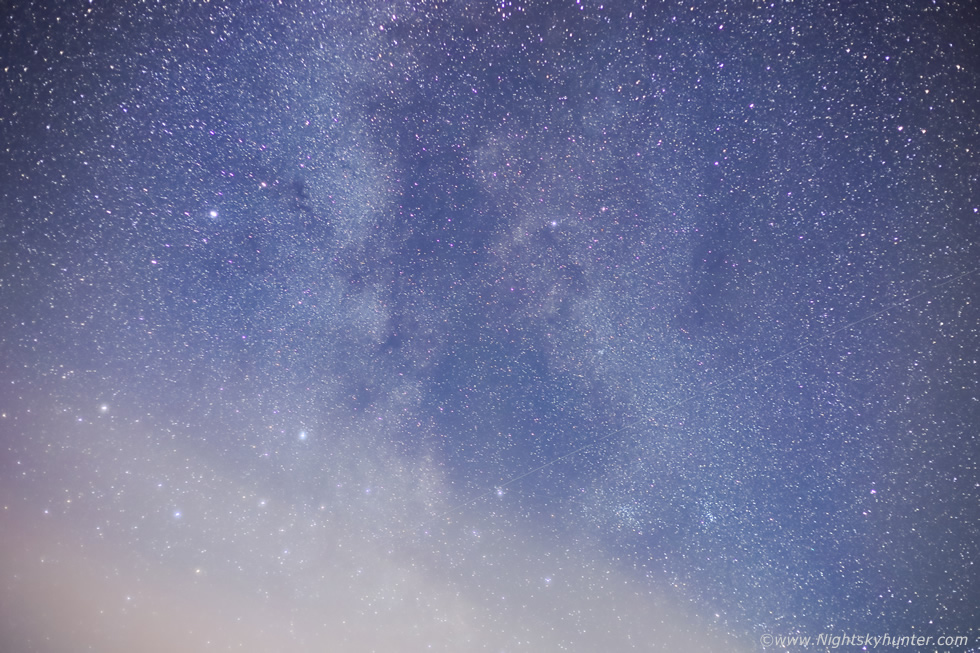 |
I began doing wide angle meteor patrols with the 15mm lens however the sky was getting so good I decided to try close up images with the 50mm F/1.8. On full frame I used ISO8000, stopped the aperture down to F/3.2 and did several 10 second exposures. I was blown away by the detail on the single exposures, here's eight images stacked using Sequator. I reckon this is the most detailed Milky Way image I have ever taken, check out the structures and depth of stars in this busy region covering Aquila and Scutum.
If anyone thinks we are along in the Universe think again, look at how many Suns there are in this image, they are impossible to count, our Milky Way galaxy has between 200 billion to 500 billion Suns, and there are over one hundred billion galaxies, the odds are high there are other intelligent civilizations out there. I was so pleased with these results that I'm now wondering what I could get with a star tracker and dark frames and stopping the lens down more to correct the coma and vignetting at the edge of field, that's another piece of gear to add to the wish list.
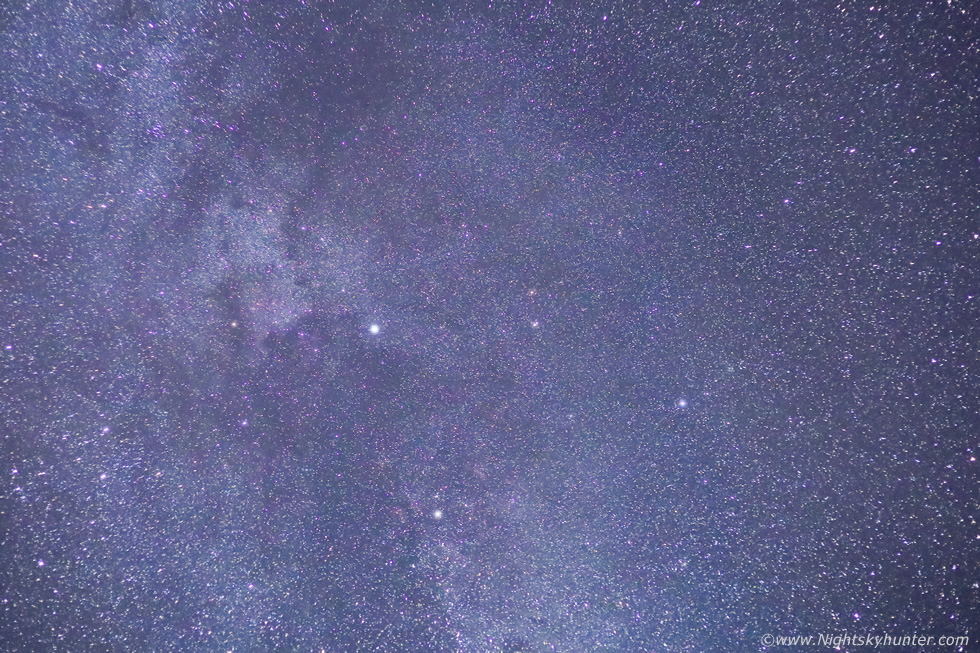 |
Camera panned higher up into northern Cygnus (the Swan) showing the bright 1st magnitude star Deneb and the North America and Pelican Nebula. There's so much more going on in this image, the bright star-rich dust lanes and dark absorption areas where dark dust clouds are literally blocking or absorping star light from behind, that's why you see those dark regions splitting the Milky Way into several streamers.
I then took out a chair and sat back watching the sky, I observed a selection of early Perseids and sporadic meteors, however what amazed me the most was the silence. I don't think I have ever heard silence like it, the sound of cows, distant cars and farm dogs barking all died down, there was literally nothing but extreme tranquility, it was almost like having an outer body experience, the only thing I could hear was the internal ringing inside my own ears!!. I really enjoyed this zen moment.
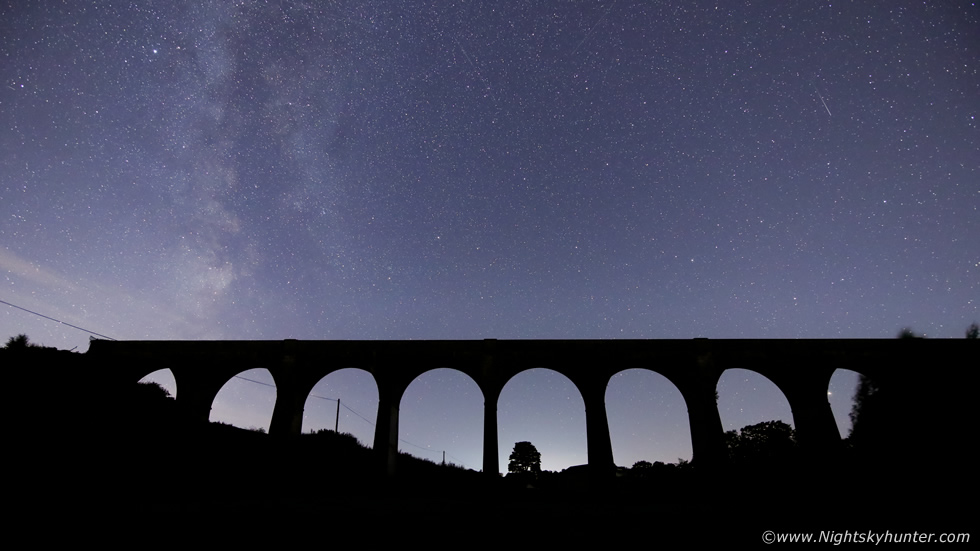 |
On August 7th Paul Martin and I arranged a night shoot with our intention focused on the Milky Way and early Perseids, but we also wanted to try new foreground. We have always wanted to visit the viaduct between Armagh and Keady so Paul and I met up and arrived on location just as twilight was fading to darkness. The only way to get a decent angle of the structure and get off the main road was to get into the field adjacent to the bridge, we looked over the fence and there was a herd of cows which had followed us all the way up to the gates. They must have seen our head torches and were curious, but this presented a problem for us as we wouldn't to be going into the same field with cows, they can be unpredictable and dangerous, we didn't want to get killed, this has happened before in recent times. We turned off our lights and walked back along the road to the other end of the field, amazingly the cows never seen us and assumed we where still at their end so they stayed in that area all night.
So we grabbed our kit and covertly went over the wire and into the field, we had to move with stealth through the grass, no noise and only talking in whispers so we didn't alert the herd, it was a little like a special forces operation, but it worked, we had peace all night and the cows never knew we were there. We spent three hours in the dew-soaked grass shooting exposures and even a short time lapse while observing random Perseids. You can't appreciate how big this bridge is until you are beside it, each archway is massive, so in order to get the entire bridge into the 15mm wide angle lens I had to back off way down the field to get it in the frame. This image shows the viaduct as how we saw it, a dark impressive and somewhat dominating structure against the stars, the Milky Way in Aquila, Scutum and Sagittarius can be seen on the left.
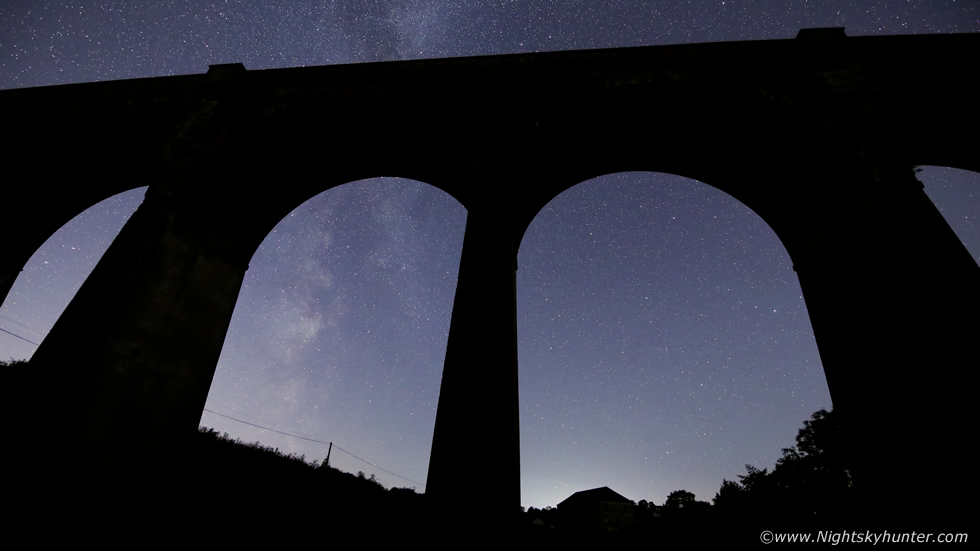 |
Shooting an exposure up close to one of the arches with Milky Way filling the arch. Somewhere in the darkness beyond was that herd of cows.
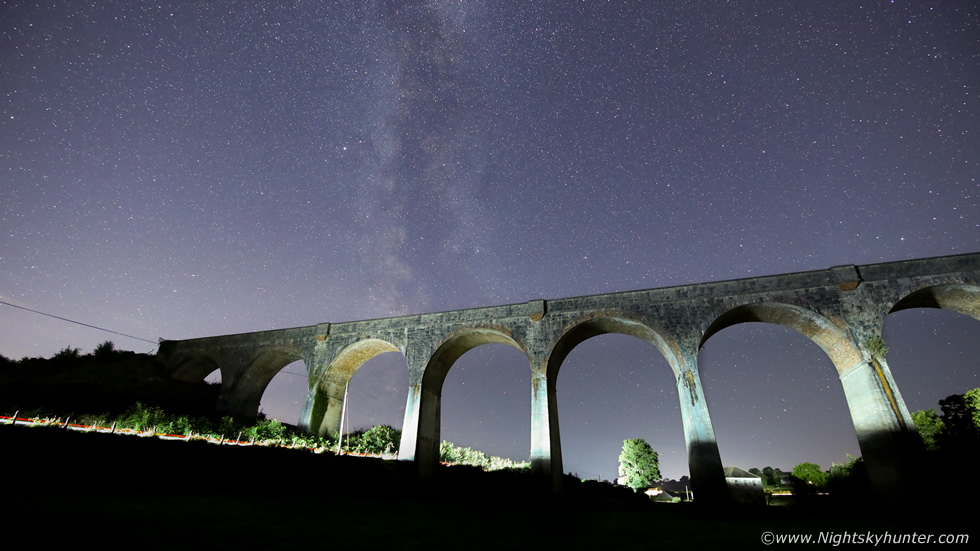 |
My favourite image from the shoot, passing traffic lit up the bridge for us, we had no control over the intensity of the light so we just had to take what we were given, we couldn't light paint the bridge ourselves as it would take many people working together in tandem to get it to work, we were content enough with the car headlights.
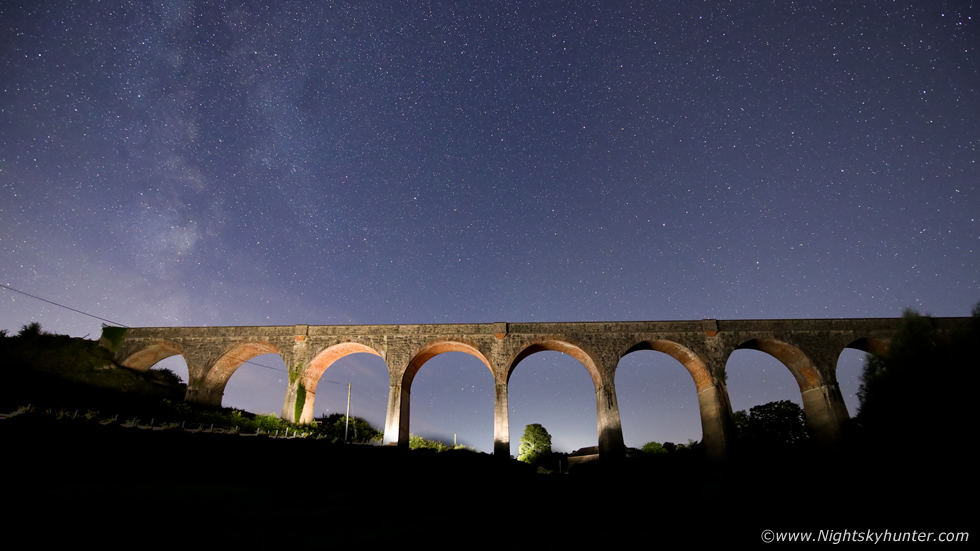 |
We were surprised how dark the sky was here despite being in close proximity to the bright lights of Armagh. It was nowhere near as dark as the country skies we are used to seeing in Co. Tyrone however it was still respectable. We could see the Milky Way with structure, I glimpsed M33 in Triangulum (always a test of a dark sky) and I glimpsed the variable star RCrB at just below the 6th magnitude. We really enjoyed this shoot, not a cloud in the sky the entire time, we where back home for 04.00.
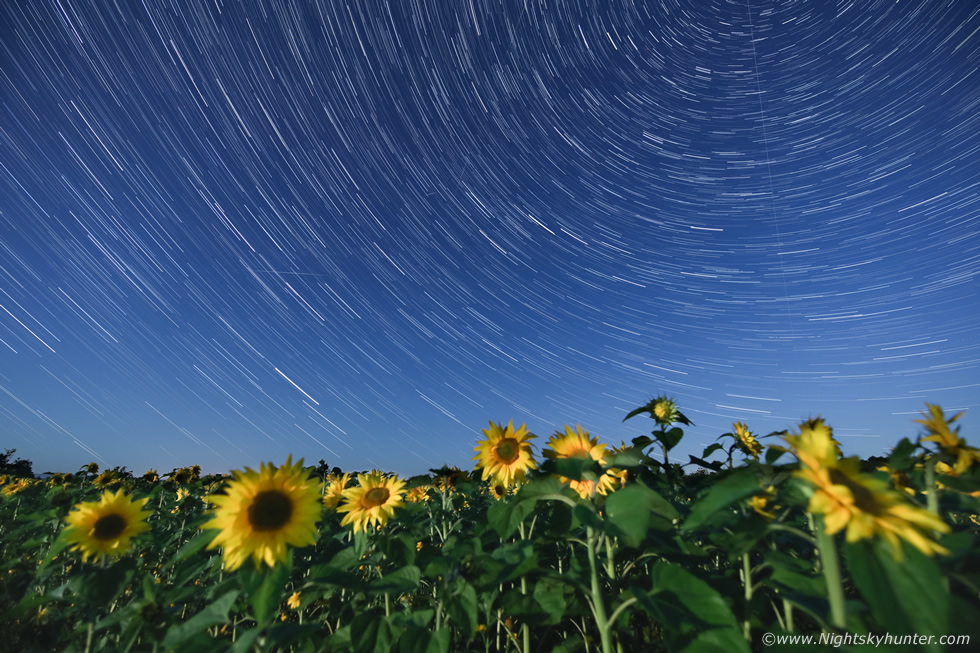 |
August 10th was another clear night and only two days away from the Perseid maximum. It was one of those classic dead calm humid and warm Summer's nights with not a breath of air. The waxing Moon would be low in the sky providing some illumination for foreground interest then later in the night the Moon would set leaving a nice dark period, the subjects again were Perseids and the Milky Way, but after the viaduct shoot I really wanted to try something new. Photographer Colleen Webb from Portglenone informed me about a new sunflower field outside her home town that was opening for the first time to the public the following day and furthermore she asked permission for us to spend the night in the field shooting the stars, so we now had an exceptionally unusual subject to shoot, and I will admit I was excited about this new adventure.
So as darkness fell I drove to Portglenone where I met Colleen, then followed her to the sunflower field, it was an ideal location out in the countryside with a perfect vantage point towards the key sky sectors. The field owners joined us, Karen and Damian McAllister, lovely people who shared a wonderful connection with nature. We chatted about the sky pointing out constellations then Damian and Karen headed home. Colleen and I ventured into the field and that was the start of a truly awesome atmospheric night under the stars. It look a little time to find the correct flowers, I wanted to take advantage of the moonlight on the flowers so I shot two star trails, when I stacked the images this was the result, I was rather pleased, and the Moon did all the work of showing the sunflowers.
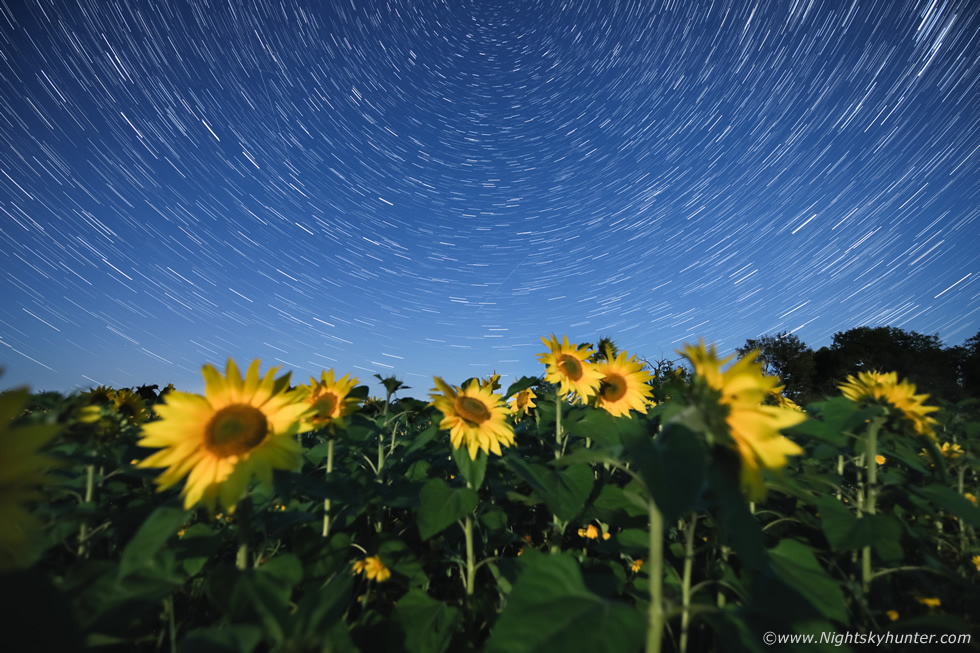 |
This was my favouruite trail, the Moon got low in the sky then the flowers appeared in shadow so this is why the trails were short, but even so I was happy with the way the images turned out.
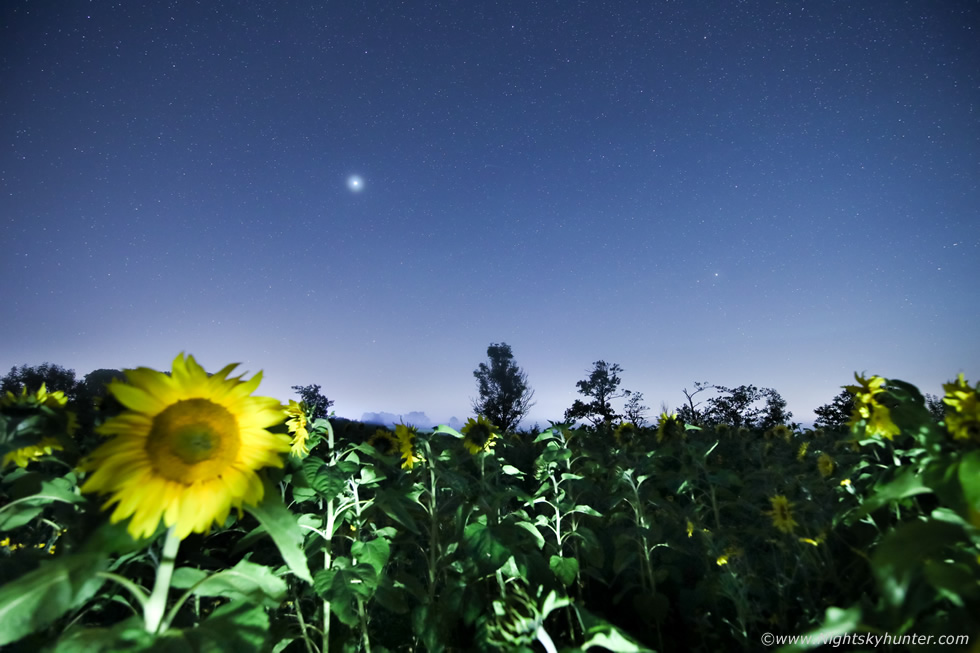 |
The Moon began to set after 03.00, there was still a good glow in the sky from its moody light, we had to use our mobile phones to illuminate the flowers, it took quite a bit of practice to get it rite, it was more art and luck than science. The bright star is mighty planet Jupiter, the dimmer star to the right is planet Saturn.
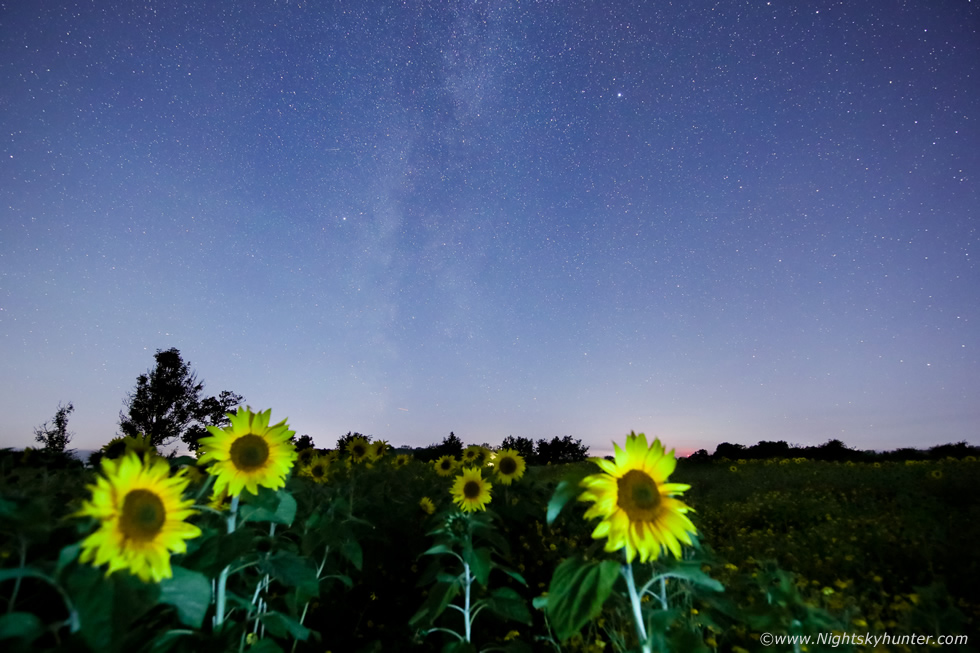 |
It was late in the night, the sky was dark, the atmosphere was amazing, silent, calm, Milky Way visible, planets and stars, I knelt down until the flowers towered far over my head, I was surrounded by a sea of stalks and sunflowers with stars aloft, it really was incredible, literally in the company of thousands of sunflowers extending across two large fields. We felt part of the night, part of the field, kneeling silently in a crop field in the dead of night felt like being in a movie like Jeepers Creepers. Banks of mist had also formed and seemed to surround the field, the mist had an eerie glow from the distant lights which really added to the atmosphere. I got the image I wanted, Milky Way over sunflowers, a single 13 second exposure at high ISO, the phone light was used to bring up the flowers.
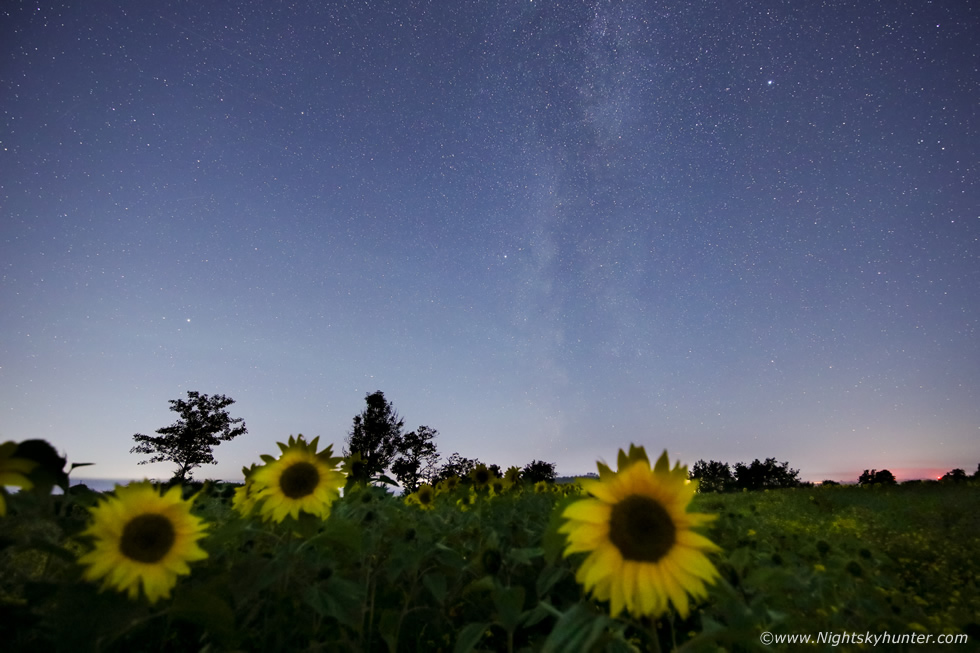 |
Milky Way and Saturn, this time no light was used, I simply used a very high ISO to get them to show.
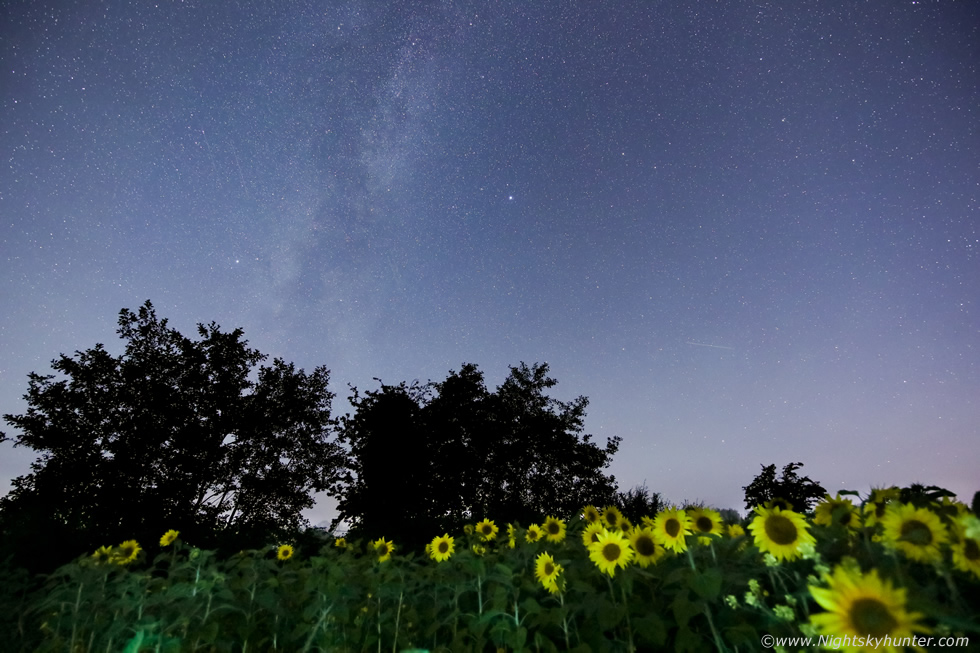 |
Colleen and I ventured off on our own to shoot various parts of the field, I found this nice cluster at the back of the first field. After 04.00 we called it a night. I have to say I really enjoyed this experience, we were both saying how epic this would be to get an NLC display or aurora over this field. Thanks once again to Karen and Damian for granting us permission. I made it home for 05.00 and went out like a light when my head hit the pillow, I likely dreamt of sunflowers as I slept.
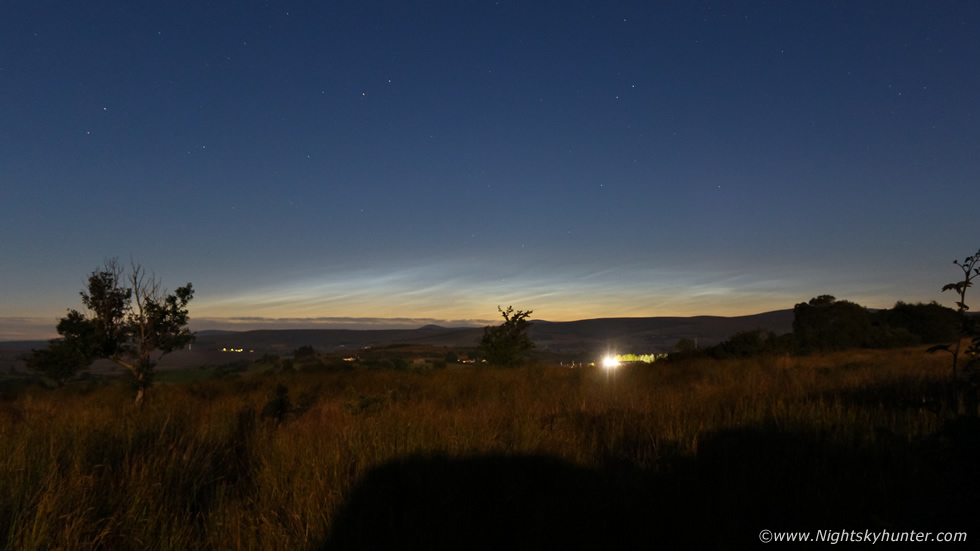 |
August 11th was also forecast to be clear for the entire night and being the night before Perseid maximum I planned on doing an all-nighter, however an almost full Moon would be visible all night long, at this time of the year the ecliptic is low so the Moon wouldn't be high in the sky so my plan was to shoot meteor patrol images in the lunar opposition region and hope for the best.
I had another motive for doing a dusk to dawn watch, there had been an outbreak of extremely late season Noctilucent Clouds (NLCs) the previous night, and I was gutted that I had missed them, I went to bed at 03.00 then after 04.30 the NLCs put on a spectacular display before dawn and I missed them. Others captured them from N. Ireland, in particular there was a spectacular image taken from Bangor Marina with moored sailing boats with NLC reflections, I was impressed because there has never been an NLC display of this caliber seen so late in the season before. This unusual activity was a combination of rocket launches feeding the Mesosphere with ice crystals and a sudden cold spell in the same region. I suspected that the chances were good of them re-appearing tonight so this was my main goal.
I was packing the van and checking the sky from Cookstown however houses obscured my horizon, by 23.00 reports were coming in on social media of NLCs so I immediately hit the road. Once on the Cookstown-Omagh road I saw them clear as day, and they were actually quite beautiful and easily covering 60 degrees of sky in extent, I couldn't find a good spot to pull over so I wasted time driving on, eventually I pulled over on a back road near Beaghmore, jumped over a wire fence and got the camera set up. They were already fading and dropping in height but they stood out very well low in the N over the Sperrins far below the paws of the Great Bear.
I didn't have time to find good foreground so everything was very rushed, the spongy Earth was making my tripod have stability issues and I had used my old 18-55mm kit lens to cover this focal range so I wasn't overly happy with the image I got, and that security light also ruined the view. However I at least got a record. 7 degrees altitude, type 3 brightness, structure was veil with IIa and IIb bands, they quickly dropped from sight as the sun lowered in altitude. This marks a new personal record for me, previous to this the latest NLC display I've ever seen was on August 8th 2014, so this sighting beats that by appearing three days later so I was delighted to experience this unique late season apparition.
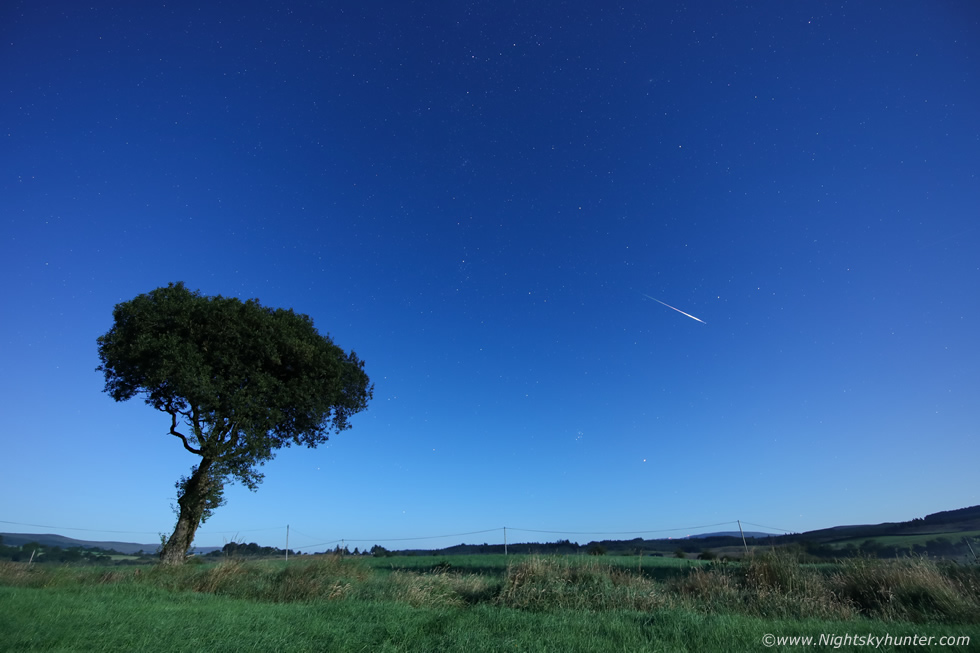 |
Later in the night I was in a field bathed in bright moonlight near Beaghmore shooting a meteor patrol over the fairy tree, I also call it Roisin's tree as she is the one who first spotted it while on a drive one day and ever since then I have been using it for foreground interest. I let the camera work away and did a proper visual watch and dome search, after several chilly damp hours I counted 13 Perseids. However I did catch this one on camera within Aries not far from the radiant at mag -2.
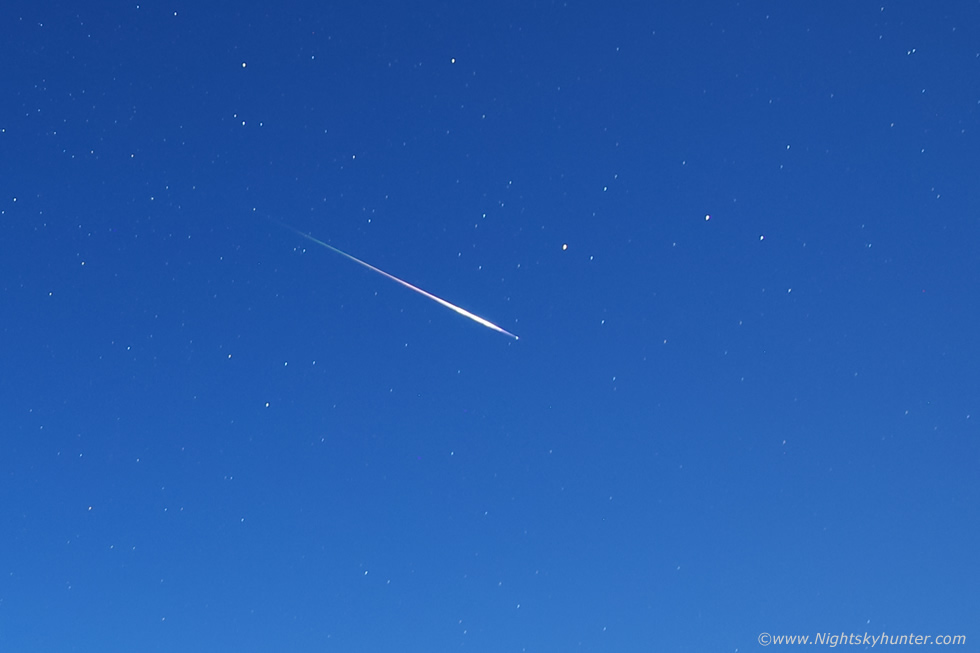 |
Deep crop, the Perseid meteors originate from comet Swift-Tuttle, what you are seeing here are tiny fragments of dust which had been ejected from the comet's coma and tail eons ago, these particles trail along the comet's orbit and every August Earth plows through that meteoroid stream and we get the Perseid meteor shower. These fragments are tiny, anyway from sub millimeter in size to several cm's, however the parent comet is many kilometers in diameter and there was a time that a collision with the Earth couldn't be ruled out. Further observations refined the orbit and we now know that we are safe for the time being, however the late Brian Marsden did say that Swift-Tuttle remains the largest and most dangerous *known* comet to planet Earth and at some stage in the distant future there's still a chance of an impact, if it did it would be an extinction-like event.
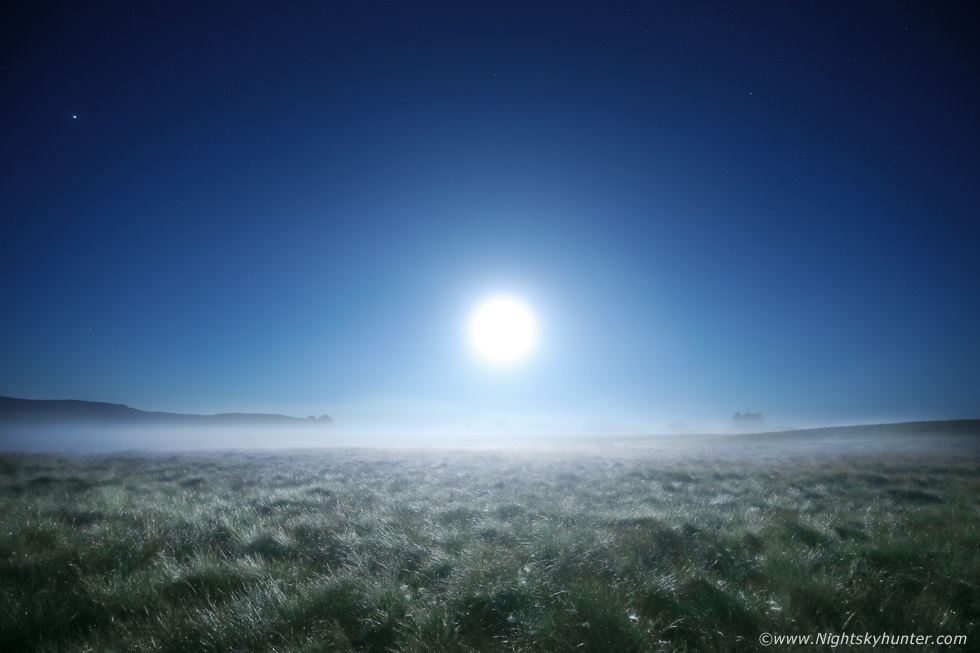 |
Later in the night I went for a drive along the back roads looking for something to shoot, I was not far from Davagh Forest when I took a narrow road which I had never been on before in my life so I took it in the hope of finding a new area to explore, and I'm glad I did. I was in the middle of nowhere, the road I was on was more like a footpath barely wide enough for my van, but somehow I managed to navigate through it. I pulled over and was taken back by the beauty of the landscape, I was surrounded by a large expanse of land covered in several moving banks of vivid moonlit mist which was quite spectacular. I saw a few isolated trees lurking in the mist in the distance so I took a chance, went over a tall wire fence, then made my way across this completely unknown land which was a combination of marsh land, bog land and wild grass. I stopped and took this exposure of the Moon, I loved the sense of isolation with the scene exploding with simplicity and serenity, it was like standing in some strange world from another dimension, I was loving it.
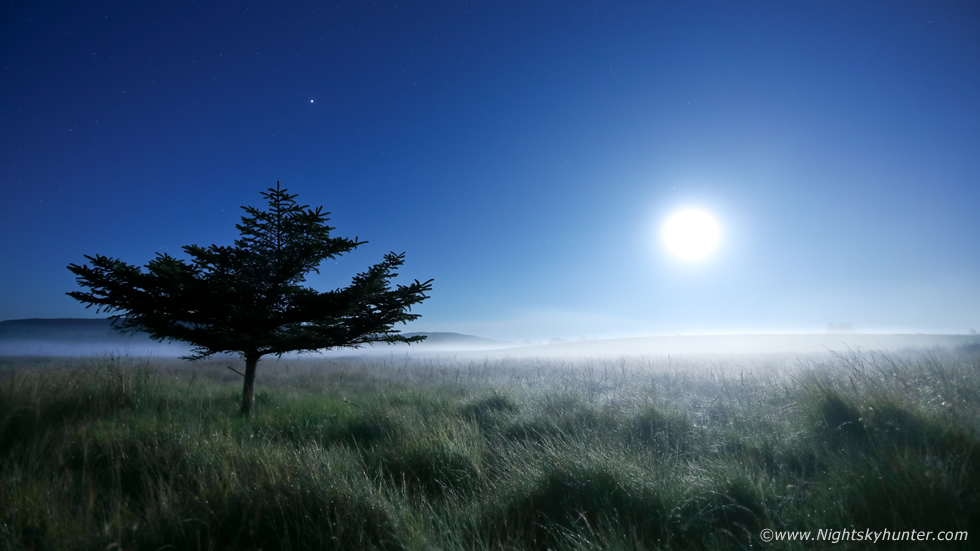 |
I walked deep into the mist and came face to face with a cow which startled me, it starred at me and I starred back, I heard others approaching behind it, I didn't take a chance, I didn't want to get charged at so I lightly jogged back out of harm's way, then I stopped and saw this really cool isolated tree, I forgot all about the cows and began working this scene, it was too good to pass up. Moonlit mist, tree with planet Jupiter (above tree) and planet Saturn (close to Moon), within that bank of mist I could see the cows appearing and disappearing like ghosts as they grazed under the Moon, they had lost interest in me. This scene made my night, it actually works well for any phenomena in the E/SE, I just need a great comet now in this region of sky.
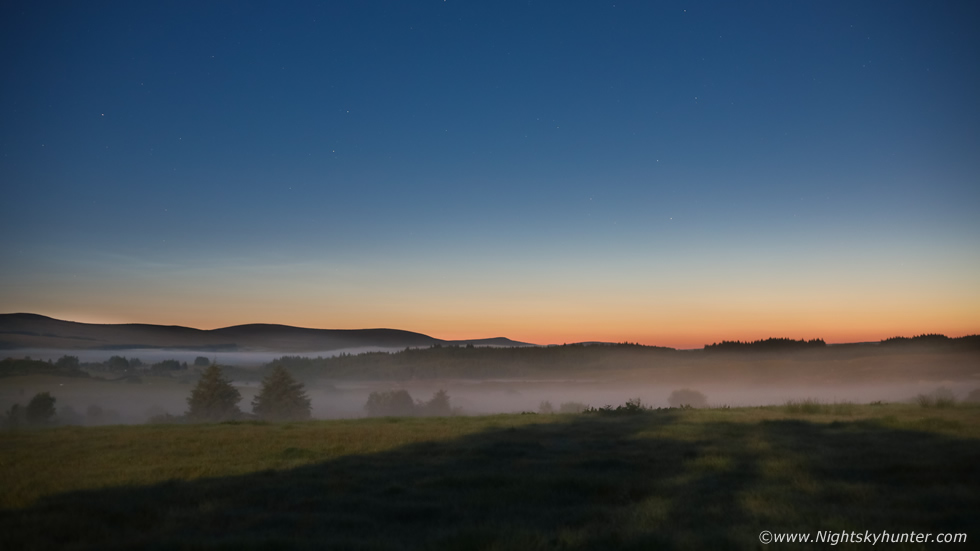 |
It was pre-dawn, I was exchanging text messages with Colleen Webb who was also watching the sky from Slemish. We figured that if we had NLCs in the evening then they could come back with vengeance in the morning sky just like the previous night and there was no way I was going to miss out this time so we stuck it out and waited. Mist covered my location so I drove back to Beaghmore and entered clear sky on higher ground then got set-up in a field facing the advancing dawn ready for the show.
The NLCs appeared, however they were a sorry sight, very faint at type 1-2 brightness with very delicate veil and soft bands, you can see them to the left on this image below Ursa Major. That was a real pity, but at least we saw something and the pre-dawn sky was so beautiful with the twilight glow, mist in the valley with a growing orange bed on the horizon with golden planet Venus within, I couldn't have asked for a better way to end this session.
It was the night of Perseid maximum, August 12th/13th, John Fagan and I had met at An Creagan to watch for a few hours because with such a bright full Moon in the sky our expectations were low. As it turned out we were pleasantly surprised, the rates were good, almost every Perseid was bright and of high quality, we observed 44 Perseids of which 4 were fireballs at the lower end of the spectrum in the mag -4.5 range. However it wasn't the Perseids which stole the show this night, it was something else entirely unexpected which threw the both of us off. This is an account of what we experienced at the time...
John and I had just set up our DSLRs and began shooting another meteor patrol to the W. At exactly 01.28 BST I glanced to the N and saw something which instantly shook me, in a staggered voice I said ''John!'', who in turn looked to the N and saw it too. What looked like a large structured object or structured 'craft' was descending in height, moving at a casual pace from S to N at a 45 angle. It looked like a cylinder or tube, well defined, or perhaps a cigar with its ends squared off. It looked to be either self luminous or lit from within as it possessed a bright orange-yellow colour, I said it looked like a glowing bus in the sky, tilted at an angle, and it was obvious it was descending in height. It was located within the paws of the Great Bear (Ursa Major) and I estimated it was 5 degrees in angular extent or 10 apparent full Moon diameters. The object then dropped out of sight below the tree line to the N, there was no sound at all, no navigational lights, no contrail, no apparent means of propulsion, no wings, the sighting lasted for perhaps 30 sec's.
John and I stood there awestruck, John said he had never seen anything like it in his life as a long term observer and fisherman who spends a lot of time out day and night under the sky. I also had never seen anything like it in 25 years of prolific sky watching. With complete modesty I consider myself to be a highly experienced observer and I was dumbstruck, this literally fell outside the realm of anything I had experienced before. John and I were transfixed to the sky in amazement unable to comprehend what we had just seen so we debated at length. We watched several planes passing over which we could identify easily due to their lights, wings, sound and the fact the Moon was illuminating their contrails and wings. It wasn't a satellite, meteor, Astronomical or Meteorological phenomena, that we were sure of. Which left only two explanations by the process of deduction, it was either manmade or a UFO. We both agreed out loud that for the time being we had just seen our first real UFO, or to use the modern terminology, an Unidentified Aerial Phenomena or UAP.
We called it a night and went home, I did a search through facebook groups as I couldn't sleep and was delighted to see others had observed the same phenomena too and were equally as shocked as we had been. It was seen from Ireland, N. Ireland and soon after from Scotland which in my mind indicated that this was a very high altitude phenomena. From Scotland eye witnesses described seeing a large comet-like tail from the cylinder, this confirmed to me it was man made and possibly some kind of spacecraft. The next day I posted on social media in the hope of solving this mystery and putting the case to rest. After a lot of research several followers on twitter found the answer, this was a Starlink G3-3 Placeholder!, I had seen Starlink trains before however this was not that, the cylinder had been a stage of the actual rocket launch itself which was descending back to Earth, and the position and time of the passage matched exactly to all the sightings.
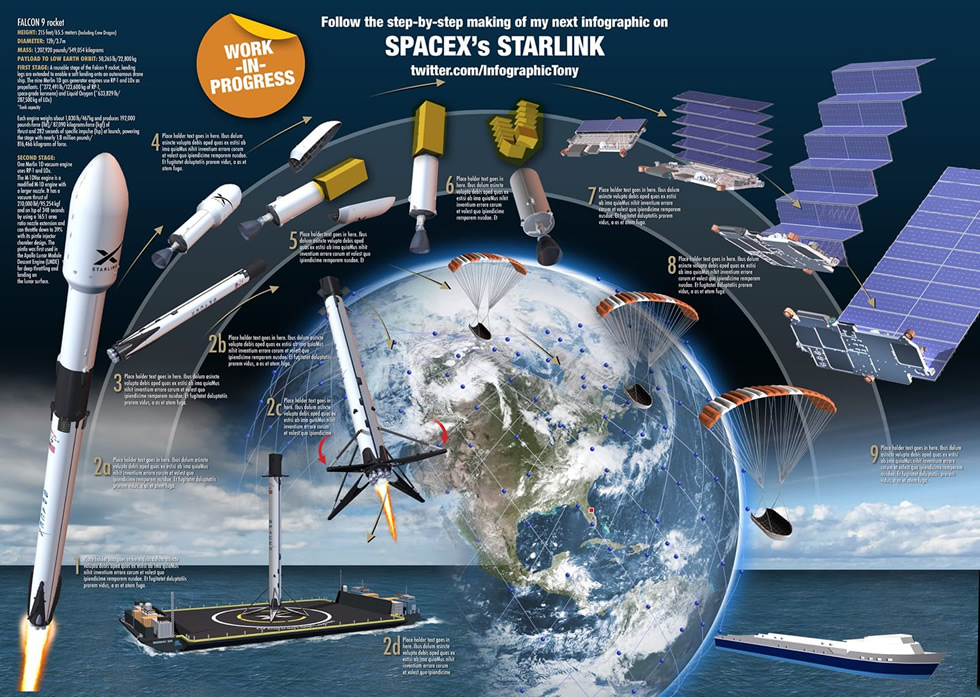 |
It felt fantastic to get an answer thanks to swift reporting and others working hard in their expert fields to solve the mystery. So, it wasn't Aliens or anything as exotic as that, however it was still a very cool sighting of something very rare to see in this part of the world. I was sent the above graphic on facebook which I hope explains what happened. John and I agreed that this was a Perseid watch we will never forget. Thanks very much for reading.
Martin McKenna